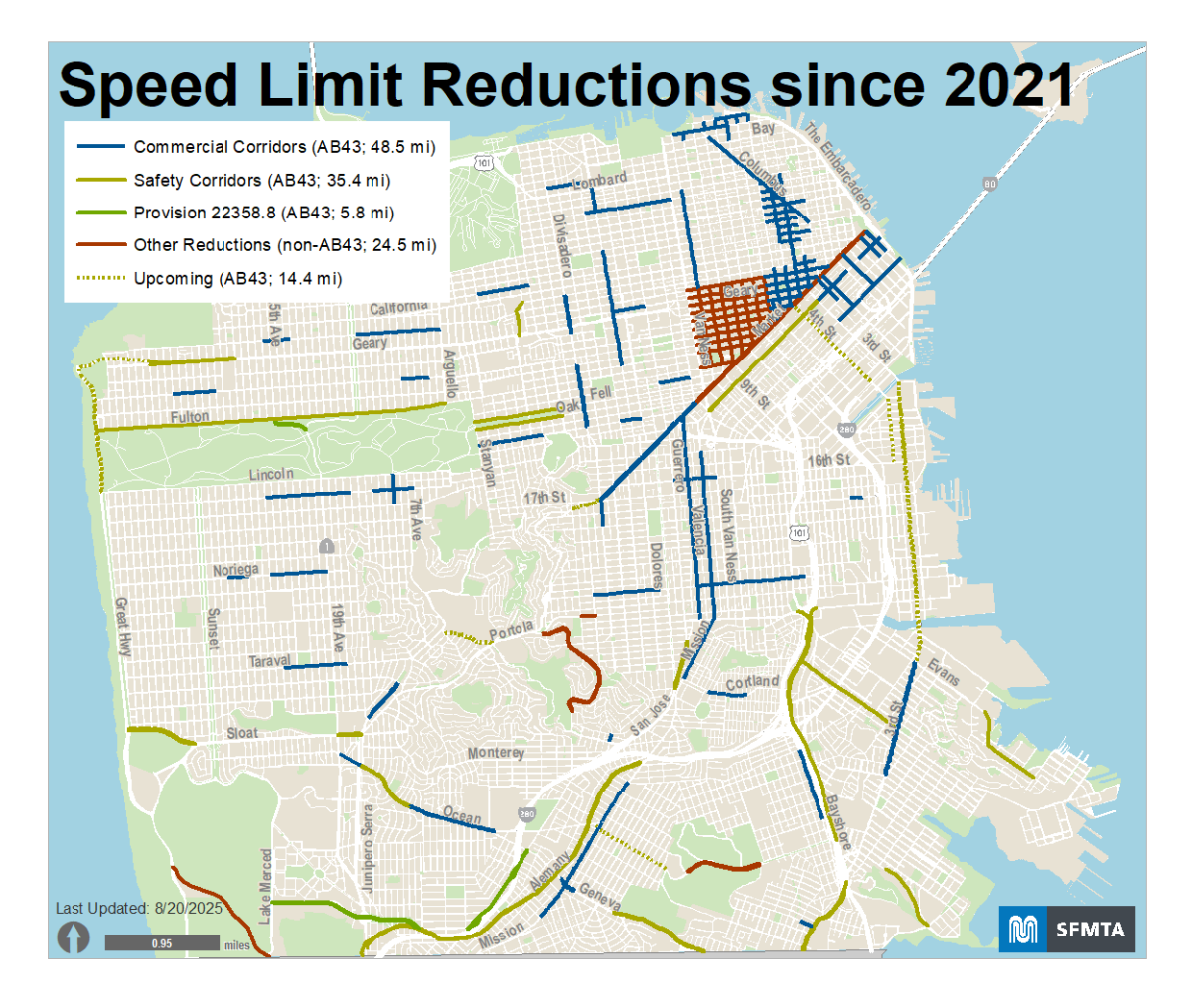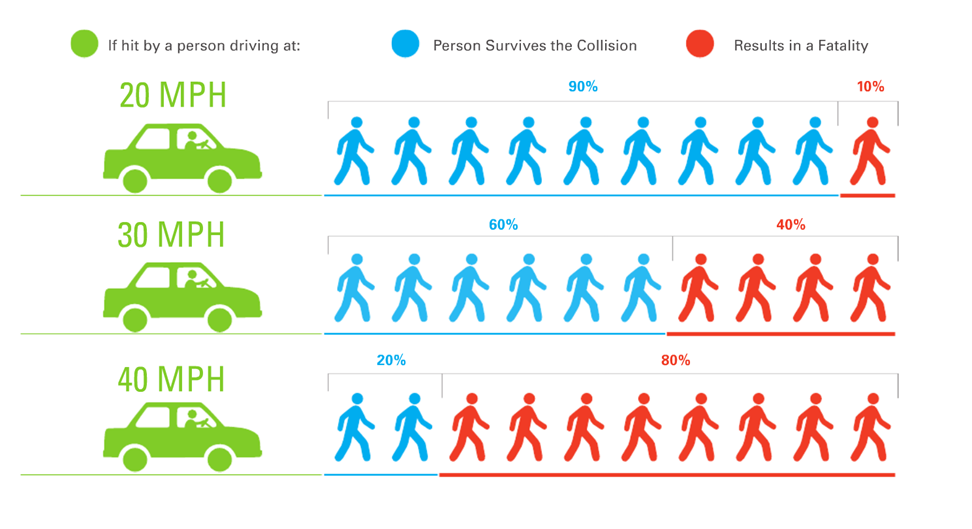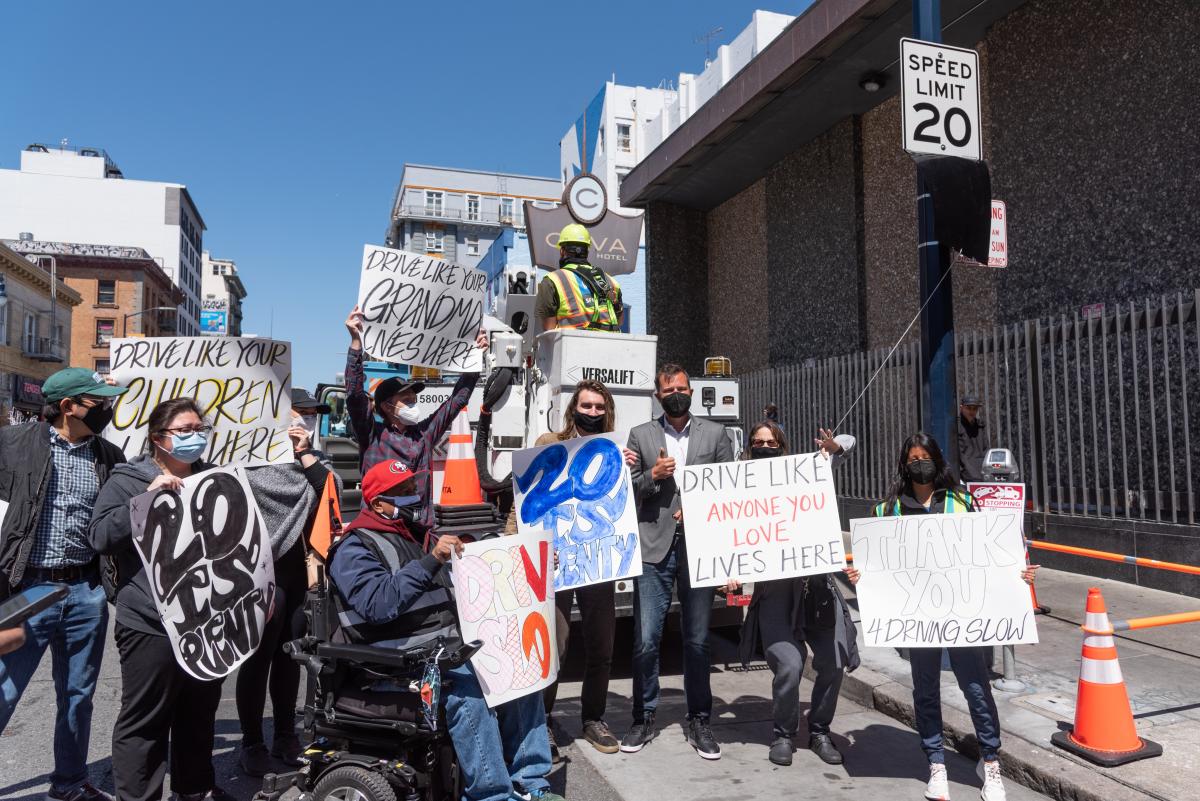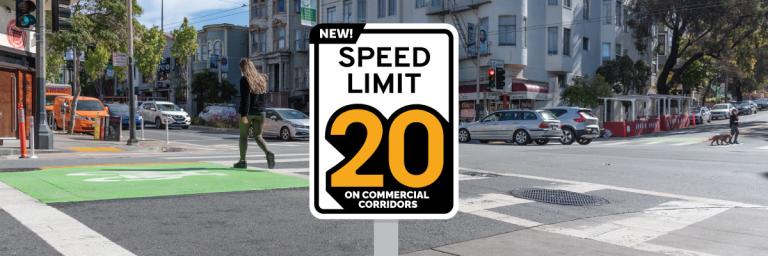Bringing Safer Speeds to San Francisco
In San Francisco, speeding is the leading cause of traffic deaths and severe injuries—and lowering speeds is the single most effective tool we can use to save lives.
Slowing speeds is a core principle of Vision Zero, the citywide commitment to end traffic deaths. San Francisco is developing and implementing a comprehensive speed management strategy that will reduce speed limits on key corridors throughout the city, alongside educational campaigns and outreach, improved enforcement strategies, and traffic calming. Under California Assembly Bill 43 (Friedman), signed into law in October 2021, San Francisco now has the authority to lower speed limits on certain streets, and the SFMTA is moving quickly to implement safer speed streets under this new legislation.
Following the legislation, slowing speeds has happened in all business activity districts, and is now happening in safety corridors:
Slowing Speeds in Business Activity Districts
Under the provision of AB 43 that came into effect in January 2022, the SFMTA is lowering speeds by 5 mph (from 25 mph to 20 mph, or 30 mph to 25 mph) in all business activity districts (streets where at least half of the property uses are dining or retail). As of September 2024, 79 corridors and 48.5 street miles have been implemented in business activity districts.
Click here for a completed list of corridors.

Slowing Speeds on Safety Corridors
Since July 2024, AB 43 also allows cities to lower speed limits by 5 mph on streets that are designated as “safety corridors,” providing additional flexibility to reduce speed limits on streets that have the highest number of severe injuries and fatalities. In San Francisco, the 2022 High Injury Network shows that 68% of severe and fatal collisions occur on just 12% of city streets. The SFMTA will review High Injury Network corridors to determine if further speed limit reductions could be established using this additional flexibility provided by AB 43. As of September 2025, 18 corridors and 35.4 street miles have been implemented on safety corridors.
Using the High Injury Network to inform Vision Zero projects, such as speed management implementation, helps Vision Zero SF center equity by prioritizing our most vulnerable communities. The transportation system should be safe for all road users, for all modes of transportation, in all communities and for people of all incomes, races and ethnicities, languages, ages, abilities, and housing status. Over half of High Injury Network streets are in an Equity Priority Community, areas of the city that have been identified as disadvantaged or vulnerable through factors such as households with low income, high levels of seniors, people who have limited English proficiency, people with disabilities, and more.
The Importance of Lower Speeds

While reducing speed limits by 5 mph may not seem like a lot, it can actually be the difference in whether or not someone survives a crash. Compared to the 20% chance of survival someone has being struck by a vehicle traveling 40 mph, a person has a 90% chance of surviving being struck by a vehicle going 20 mph. Lower speed limits make streets safer for all users: when drivers move more slowly, they give themselves more time to notice other drivers, cyclists, and pedestrians, and they contribute to a calmer, safer environment on the street.
Speed Management: More than Lowering Speed Limits!
Introducing lower speed limits across the city is a significant step forward in San Francisco’s progress toward Vision Zero. Data from peer cities like Seattle has shown that signage alone can lower driver speed and reduce the number of crashes. But San Francisco is committed to taking a holistic approach to speed management. Signage is one piece of this work, but the SFMTA is also focused on implementing street design improvements that encourage slower speeds and create safter streets for all.
Other Speed Management Efforts in San Francisco
Children and older adults are some of the most vulnerable to speed-related crashes and injuries. Addressing vehicle speeds where they are next to or crossing streets creates a safer, more walkable, bikeable, and livable environment. School and Senior Zones encourage slow speeds (15 mph and 25 mph, respectively) where there are high numbers of children or seniors. Under Assembly Bill 321 (Nava), which was passed in 2007, local authorities are allowed to implement 15 mph speed limit zones where applicable within 1,000 feet of schools, while children are present. In 2011, San Francisco was the first large city in California to lower speeds to 15 mph at about 200 public and private schools - 100% of schools eligible under state law. Senior Zones were established in 2020 to lower speeds to 25 mph near some senior living facilities and centers.
The California Vehicle Code § 110 provides that the City and County of San Francisco may designate by ordinance or resolution as an “alley” any highway having a roadway not exceeding 25 feet in width, and allows alleys to be posted for 15 mph.
Finally, in 2021, the SFMTA implemented the first neighborhood-wide 20 mph speed limit zone in the Tenderloin, where every street is on the High Injury Network.
Learn more about SFMTA programs to create safer streets and encourage slower speeds:
- Vision Zero Quick-Build Program
- Residential Traffic Calming Program
- Slow Streets Program
- Neighborhood-wide 20 mph speed limit zone in the Tenderloin
Promoting a Culture of Traffic Safety
Vision Zero aims to engage people to first acknowledge that traffic deaths are a preventable problem and then empower people to promote traffic safety through individual actions and behaviors that collectively build a culture prioritizing traffic safety. Education and outreach play an important role in raising public awareness, encouraging safer driver behaviors, influencing policy discussions, building community support to end traffic deaths, and are best leveraged when used in coordination with other safety interventions.
Year-to-year survey results tracking brand awareness as a proxy for public support indicate an increasing number or residents are aware of Vision Zero SF. Public perception of the dangers of speeding is also trending in the right direction each year, indicating a sustained change in attitudes influenced by education campaigns, policy decisions, and engineering since Vision Zero was adopted in 2014.
Speed management implementation will build on these efforts and pair education strategies to reach impacted drivers, residents, merchants, and neighborhoods using strategies such as multilingual outreach, targeted digital advertising, physical advertising on bus shelters and light pole banners, and more as funding permits.
Thank You!

The SFMTA is proud to implement the safer speed limits authorized by AB 43—and recognizes that the passage of this transformative legislation was the result of years of advocacy by Walk San Francisco Foundation, San Francisco Bay Area Families for Safe Streets, San Francisco Bicycle Coalition, and all the many citizens who wrote letters, called into hearings, and voiced their support on social media for safer speeds. We appreciate their commitment and the leadership of Assembly Transportation Committee Chair Laura Friedman, San Francisco co-sponsors former Assemblymember David Chiu and Assemblymember Phil Ting, along with Mayor London Breed and the Board of Supervisors. We stand committed to safer streets in San Francisco and will work urgently to reduce speed limits to save lives.
